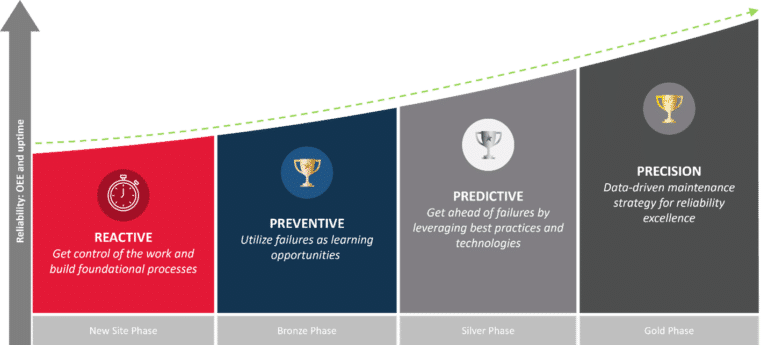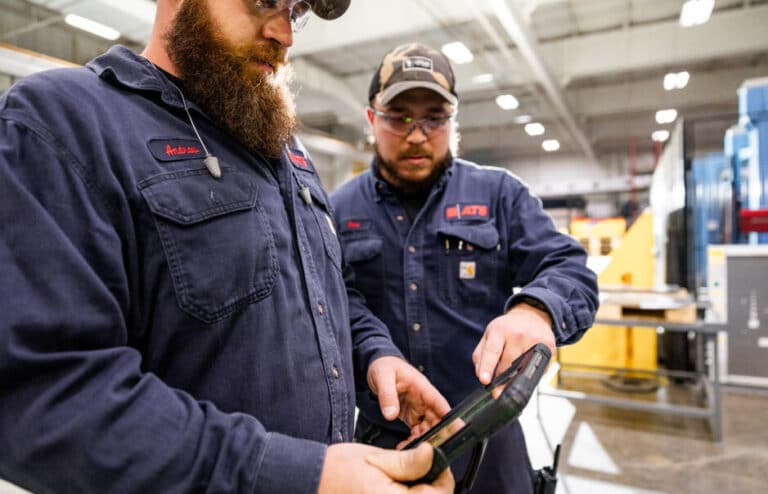Precision maintenance is typically discussed alongside strategies and concepts like predictive maintenance, smart manufacturing and Industry 4.0 — and it does indeed have relationships to each of those areas. It is, however, its own distinct and discrete approach, focusing on a series of core tenets:
- Consistency and repeatability across maintenance processes
- A drive towards accuracy and efficiency
- An eye towards maximizing resources, increasing value and improving the bottom line
Whereas a term like predictive maintenance refers to specific technology, hardware and methodology, precision maintenance takes a bigger-picture, strategic point of view. In an effective precision maintenance framework, the following should take place:
- Maintenance processes occur consistently and identically, regardless of the technician carrying out the task.
- The quality level and outcome of every maintenance process is predictable and consistent.
- Industry best practices and standards are reliably applied and met.
Throughout this article, we will explore how to implement a precision maintenance plan and what the benefits are.
Precision maintenance workflow
In an effective precision maintenance workflow, the following steps should be present:
Set standard operating procedures
Managers and technicians should work to define the necessary SOPs for the maintenance processes required throughout the facility, with a specific SOP for each machine. These procedures form the underpinning of consistent, repeatable processes. SOP tenets include processes to monitor, metrics to act upon, troubleshooting steps and proper remedies.
Hire & train technicians
It is critical to have the right personnel on hand to carry out the above defined procedures. In the age of the continuing skills gap, a rigorous SOP process can help to overcome some of the learning curve of precision maintenance training for newer workers. That said, trained, skilled technicians are always a necessity to maximize maintenance efficiency and efficacy.
Maintain an efficient facility working environment
Maintenance technicians should be able to carry out their tasks quickly and without roadblocks or confusion. In order to accomplish this goal, technicians must have fast, easy access to instructions, documentation, tools and parts.
Monitor & document maintenance procedures
In the interest of transparency and efficiency, maintenance procedures should be clearly documented, with documentation easily accessible. Maintenance processes should be monitored for transparency, with any deviation from the expected procedure and outcome analyzed for future improvement.
Analyze & improve maintenance plan
Continuous improvement is a key component of the truly efficient facility, and the vast amounts of data available through today’s technology, such as industrial sensors and performance monitors, make it easier than ever to engage in this practice. The technicians carrying out maintenance processes will almost always yield the most useful insights into what is and isn’t working, and they should be deeply involved in iterating upon existing procedures.
Precision maintenance requirements
The following are required for effective precision maintenance:
Skilled technical workforce
A skilled technical workforce is a necessity to carry out effective maintenance practices with the repeatability and consistency necessary for precision maintenance. Even with the most detailed procedural documentation available, proper training and experience is the only way to take full advantage of a precision maintenance strategy.
Detailed procedures & outlined workflows
Put 10 technicians in front of a machine requiring maintenance, and, without a defined procedure, you are likely to receive 10 different, if similar, approaches and remedies. Detailed procedures and workflow outlines are the only way to ensure the consistency and repeatability required of precision maintenance.
Ongoing technical training
Today’s industrial technology remains fast-changing, with sensors, communications technology, analytics and information delivery systems such as immersive technology all playing a part. Industrial maintenance training is a critical requirement to ensure that personnel are able to navigate this ever-shifting landscape while keeping everyone on the same page, with the same baseline knowledge.
Accurate documenting of maintenance
Maintenance procedures and outcomes must be properly and accurately documented so that technicians and managers can monitor and assess the degree of consistency and accuracy with which tasks are being carried out.
Quality materials and inventory
Without high-quality tools and parts on hand, technicians are unable to achieve high-quality outcomes. Cheaper, low-quality parts can lead to unpredictable results and more unplanned downtime — scenarios that run counter to precision maintenance and lead directly to higher resource usage and overall costs.
Continually updated procedures
Continuous improvement remains critical in today’s Industry 4.0 landscape. In order to achieve a truly effective precision maintenance plan, facilities should make use of data and documentation to improve and pursue perfection in maintenance processes.

Benefits of precision maintenance
The many benefits of implementing precision maintenance include:
Improve efficiency with less downtime
A precision maintenance approach focuses on predictability and repeatability, both of which yield increased efficiency. Taking a consistent approach to accurate, high-quality maintenance means that equipment is far less likely to experience unplanned downtime, since managers and technicians have a defined approach for monitoring equipment performance and carrying out maintenance when problems are identified — not when problems cause catastrophic failure.
Predict maintenance & prevent breakdowns
Predictive maintenance solutions are among the most significant efficiency drivers in manufacturing today, enabling manufacturers to vastly reduce or even fully avoid unplanned equipment breakdowns and shutdowns.
Improve processes based on data & employee feedback
By drawing on data as well as the deep, hands-on knowledge of employees carrying out maintenance processes, facilities are able to continuously iterate and improve upon processes in the ongoing pursuit of 100% accurate and timely maintenance with zero downtime and maximum equipment value through uptime.
At ATS, we take an outcome-focused approach to developing the right maintenance strategy for you, focusing on uptime, productivity and cost efficiency in your maintenance processes. We offer deep expertise in industrial technology, data analytics, training and technician development, delivering the services and people that you need to retain a competitive edge for your business. To learn more, contact us today.


